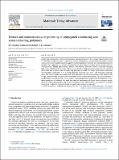Texture and nanostructural engineering of conjugated conducting and semiconducting polymers
Author(s)
Heydari Gharahcheshmeh, M; Gleason, KK
DownloadPublished version (8.612Mb)
Publisher with Creative Commons License
Publisher with Creative Commons License
Creative Commons Attribution
Terms of use
Metadata
Show full item recordAbstract
© 2020 The Author(s) Conducting polymers have attracted tremendous attention because of their unique characteristics, such as metal-like conductivity, ionic conductivity, optical transparency, and mechanical flexibility. Texture and nanostructural engineering of conjugated conducting polymers provide an outstanding pathway to facilitate their adoption in a variety of technological applications, including energy storage and harvesting devices, flexible optoelectronic devices, and wearable electronic devices. Generally, obtaining high carrier mobility in the presence of high carrier density is challenging and requires precise control of the texture and nanostructure of conducting polymers to avoid the charge localization. Preferential semicrystalline orientation, π–π stacking distances, crystallite size, intra- and interchain couplings, intra- and intercrystallite connections, and grain boundaries are the key parameters that influence the charge carrier mobility and needs to be controlled by the synthesis parameters. This article provides a comprehensive overview of the recent texture and nanostructural engineering development of conducting polymers. In addition, this work describes the fundamental of charge carrier transport mechanisms in conducting polymers; and the latest progress on the optoelectronic characteristics of flexible transparent conductive electrodes based on conducting polymers is reported.
Date issued
2020Department
Massachusetts Institute of Technology. Department of Chemical EngineeringJournal
Materials Today Advances
Publisher
Elsevier BV